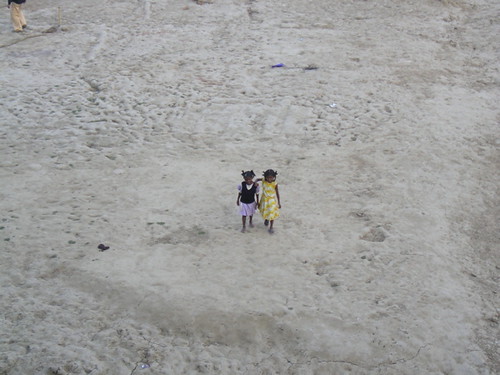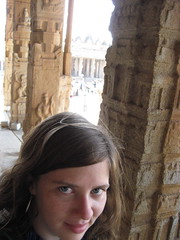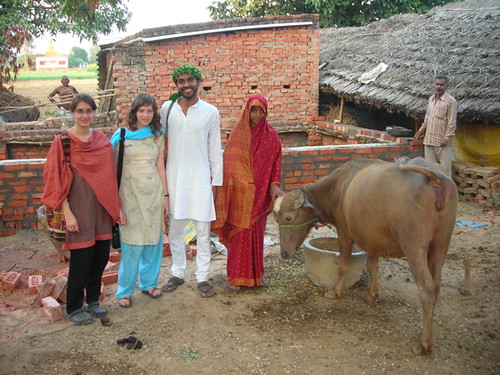
This Thursday and Friday, Andria, Prashant and I went with a colleague to a rural area about an hour outside of Varanasi, to visit one of the small local NGOs that World Literacy of Canada supports. For Andria and Prashant, these NGO visits are an important part of their work, but I went along on the visit mostly for fun and interest’s sake. We stayed at the headquarters of the organization (the site of their office, their small clinic, and the family home of the founder), and spent our days rumbling around the countryside in a big SUV visiting the villages where they work. The roads were narrow, just wide enough for one car, and raised a few feet above the level of the farmers’ fields on either side. Although the roads can handle cars, cars are scarce, and so our passage met with a number of funny obstacles. We had to wait for various kinds of livestock to get off the road, of course (that goes without saying anywhere in India, in big city or small town), but we also had to squeeze past bicycles carrying huge loads of sticks on the back, stop where farmers had run fat irrigation hoses over the roads and call the hose’s owner to switch it off so it wouldn’t burst when we drove over it, and re-route our day’s visits after we were stopped by bamboo scaffolding in the middle of the road, where a gate to mark the entrance to a village was being constructed. In once case, a local farmer had dug an irrigation ditch a couple of feet deep right through the middle of the road, and our driver and a staff member of the NGO had to get out of the car and spend several minutes collecting loose paving stones to rebuild two small sections of the road, just wide enough to accommodate the two wheels of our car.
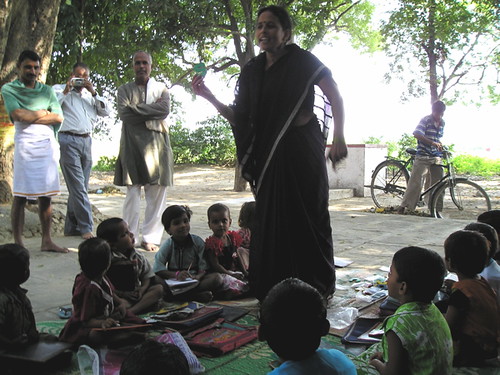
In the villages, we visited nursery schools for children, adult literacy classes for women, “gumpti” libraries (tiny libraries set up inside small wooden sheds), and various businesses and income generation activities which had been started with the assistance of small loans from the NGO. These included everything from general stores to seamstress shops to potato farms to buffalo and cattle kept for milk. At each site we were welcomed warmly and plied with cup after cup of hot chai and dishes of sweet biscuits (of the omnipresent “Parle G” brand).
I met many people during this visit, but two of them especially will stay with me. One of them was a tiny little girl named Rochni, not yet two years old. Usually, the children I meet here are a little bit afraid of me until they get to know me, especially in the villages where foreigners are not a common sight. Rochni was a little bit shy at first, hiding from me behind the skirt of her dress when we first arrived in her village, but when we started a walking tour of the village to visit some of the farms which had been supported by loans from the NGO, and she started to follow us holding the hand of another little girl who was maybe six, I offered her my hand to hold on the other side. She hesitated for a moment and then took it, and walked along between the two of us with a very serious look on her face. I think she was still a little unsure how she felt about me until the first time I hoisted her up by the arm and “flew” her over a puddle. After that, I was cool. Every time our hands were separated, she’d search around for me frantically, and the look of glee on her face as she soared over the puddles was delightful.
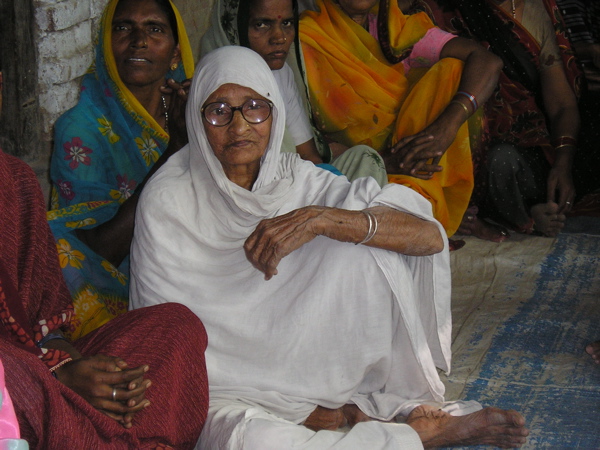
The other amazing memorable person I met was an old woman called Sakina. This is her. She was a member of one of the Mahila Mandals (women’s solidarity groups) in one of the villages we visited, and was also a member of their adult literacy class – in fact, she had been one of the main local advocates for setting it up a couple of years ago, because she wanted so badly to become literate. When the literacy class was first set up, and she first began to read and write, Sakina was in her 70s. Sakina has an account at the local bank, where she keeps the proceeds from the small shop she opened with the help of one of the NGO’s loans. In India, most banks allow their illiterate customers to sign for their accounts with thumb prints rather than signatures. Sakina has signed her name this way for most of her life, but she told us with pride that now, whenever she goes to the bank and they offer her the ink pad to make her thumb print, she pushes it away, reaches for a pen, and proudly writes “Sakina”.
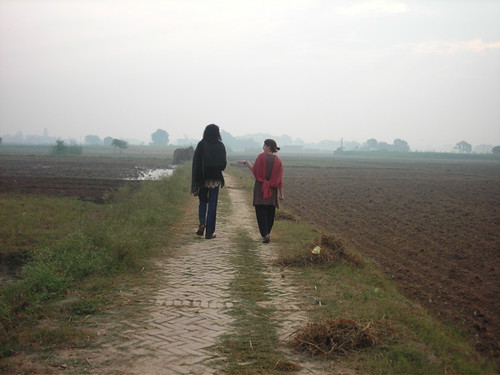
It was wonderful to be away from the noise and grime and dust and madness of the city. In the evening, before dinner, Prashant and Andria and I lay on a shawl on the roof of the NGO’s office, watching a sky thick with more stars than I’ve yet seen in India, singing cheesy old campfire songs and wishing on the shooting stars. In the early morning the next day, we went for a walk along the narrow paths raised between the green, dewy fields. It was so quiet and peaceful and beautiful. I had started to think of India as always loud and crazy and busy, but that’s only one aspect of it.
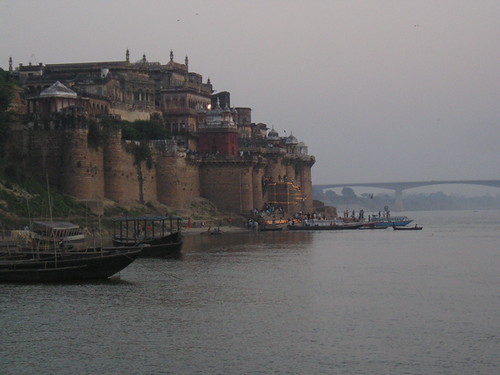
This weekend has been good – on Saturday a dinner party at an international student residence near here, and on Sunday a visit to Ramnagar fort, which has belonged to Benarasi maharajas for something like a couple of centuries now. It’s now crumbling – although parts of it are occasionally restored to be part of movie sets – and houses a museum of the past and present Maharajas’ various interesting belongings, which are in an even greater state of decay than the fort itself. In the museum we saw decrepit palanquins and haudas (the enclosed seats that go on top of elephants) and cars, and carriages, the once-rich upholstery faded and torn to shreds. We saw the moth- and mouse-eaten elaborate clothing that once dressed maharajas and their wives, continuing to be chewed by moths and mice in the glass cases that now house them (there were actual mouse droppings on some of the fabric) and a stuffed alligator that was so decayed that you could see more of the taxidermist’s mold under the skin than of the actual skin itself. The hilight of the museum was a collection of stunningly delicate ivory carvings. Harvesting ivory is a cruel process, but it was good to see the material respected so deeply in the attention given to each minute detail of the carving.
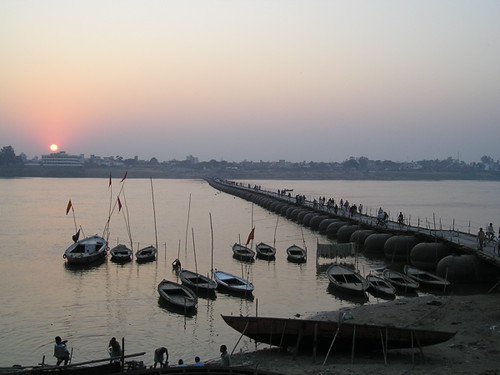
Ramnagar fort is on the Ganga’s east bank, and we live on the west. We crossed the river on foot across the recently completed pontoon bridge, constructed of a series of planks on top of large floating tanks. The bridge creates a bit of a bouncing and swaying sensation as you cross, and the bicycles and motorbikes sharing the bridge made the crossing a bit nerve wracking, but it was really quite beautiful to be able to stand out in the middle of the river and look out at the city curving away along its western bank. Crossing back in the early evening, we got to see, for the first time, the sun setting over the Ganga.
Love,
Emily
